Astroparticle Physics Research
Astroparticle Physics Research
Gamma Rays
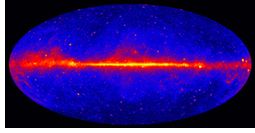
Gamma-ray photon energies range from 20 keV and up, encompassing the highest energies in the electromagnetic spectrum. Produced in extreme astrophysical environments, celestial gamma-rays are not easily scattered or destroyed, offering direct tracers of fundamental physical processes. Astroparticle Physics Laboratory scientists and engineers have had extensive involvement in gamma-ray instrument development. This incorporates scintillator and spark chamber technologies as well as recently developed solid state cadmium zinc telluride array detectors. Past Laboratory supported gamma-ray missions include the TGRS/WIND, SAS-2, GRIS balloon experiment and the Compton Observatory's EGRET instrument. Present missions include INTEGRAL, Swift, and Fermi. The unique Laboratory-supported GCN program currently provides rapid, world wide electronic notification of transient events related to gamma-ray astronomy.
What shines in the gamma-ray sky? Lab research groups are also involved in theoretical and observational gamma-ray astrophysics in areas including;
Gamma-ray Bursts - Gamma-ray bursts are the most significant explosions in the universe, and their origin represents one of the biggest mysteries in modern astrophysics. Astronomers believe that these explosions occur when exotic massive stars run out of nuclear fuel. As the star~s core collapses into a black hole, jets of material powered by processes not fully understood blast outward at nearly the speed of light. These jets bore there way though the collapsing star and continue into space, where they interact with gas previously shed by the star, and generates bright afterglows that fade with time.
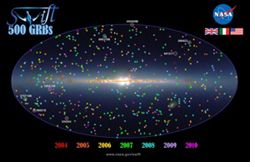
Supernovae and Supernova Remnants - Gamma-ray emission lines produced by the decay of radioactive isotopes in expanding clouds of stellar debris detail the dynamics of the expansion and can trace young supernova remnants throughout the galaxy. In addition, gamma-ray emission from supernova remnants may identify them as a source of galactic cosmic rays. Astronomers believe that if it were not for a relatively nearby supernova explosion in the past, there would be no Sun or Earth.
Pulsars - A pulsar is a neutron star which emits beams of radiation that sweep across the earth's line of sight. The core of the star collapsed to form a rotating neutron star, one of the most exotic objects known to modern astronomers. Gamma-ray observations of pulsars constrain emission models while probing physical laws under the conditions of extreme gravitational and magnetic fields.
Galactic Center - The electron-positron annihilation feature at 0.511 MeV is used to probe various astronomical sources and physical conditions in the galactic center region.
Galactic Diffuse Emission - Galactic Diffuse Emission consists of many components: truly diffuse emission from the interstellar medium, the extragalactic background, whose origin is not firmly established yet and the contribution from unresolved and faint Galactic point sources. One approach to unravel these components is to study the diffuse emission from the interstellar medium, which traces the interactions of high energy particles with interstellar gas and radiation fields.
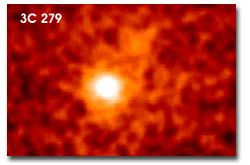
Active Galaxies - Gamma-ray flares can be produced in active galaxies. Time resolved gamma-ray observations are required to explore the physics and energetics of the flares. Active galaxies are those with unusually bright centers that show evidence of particle acceleration to speeds approaching that of light itself. These are super massive black holes that spew forth tremendous amounts of energy from jets emerging along their axis of rotation.
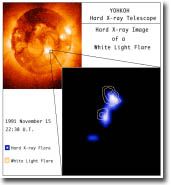
Solar Flares - A solar flare is an enormous explosion in the solar atmosphere involving sudden bursts of particle acceleration, plasma heating and bulk mass motion. It is believed to result from the sudden release of energy stored in magnetic fields that thread through the solar corona in active regions around sunspots. Gamma-ray spectroscopy of strong solar flares reveals powerful particle accelerators producing nuclear emission and decay lines. Solar flares were first detected from their signatures in visible light. These so called "white light" flares are rarely reported since they are difficult to detect against the intense and constant visible light from the photosphere.
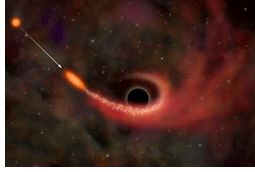
Tidal Disruption Events - When a star approaches too close to a massive black hole, it can be torn apart. The gas is then accreted. The signature is a bright gamma-ray transient lasting a day, followed by X-ray afterglowlasting for a year.
Cosmic Rays
Cosmic rays, particles that have been accelerated to high energies, can originate at the sun, in interplanetary space, or in supernova remnants and other energetic events in the Galaxy and beyond. Although cosmic rays have been studied for many decades, the specific sources, acceleration processes, and their propagation are still not well understood, and are the subject of ongoing research here in the Astroparticle Physics Laboratory. Cosmic rays are a unique sample of matter from different regions of the universe, and they also provide important probes of the dynamics and evolution of the Sun~s heliosphere and our Galaxy. Technologies include silicon solid state detectors, silicon strip detectors, and magnet spectrometers with Cerenkov detectors, scintillators, and time-of-flight systems.
Specific scientific topics currently being studied include:
Cosmic Ray Composition - The relative isotopic and elemental abundances of cosmic rays provide a fingerprint of their sources. In addition, the abundance of several radioactive isotopes can determine important timescales, such as the lifetime of cosmic rays in the galaxy or the delay between nucleosynthesis and acceleration.
Antimatter - Secondary cosmic ray antiprotons have been observed for many years. Detection of primary antiprotons or heavier antinuclei, as yet unobserved, can test Grand Unified Theories or be evidence of dark matter candidates.
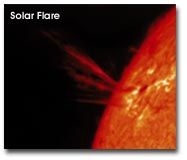
Solar Energetic Particles - Current experiments seek to understand the acceleration process in both solar flares and Coronal Mass Ejections (CMEs). They are also seeking to understand why the abundance of 3He can vary by orders of magnitude from flare to flare and why heavy ions are frequently enhanced in 3He-rich events.
Electrons and positrons - These particles are unique in their ability to enable study of charge-sign-dependent solar modulation effects such as drifts in the spherical solar wind cavity. As with the antimatter, detection of primary positrons can give evidence for dark matter candidates or Grand Unified Theories.
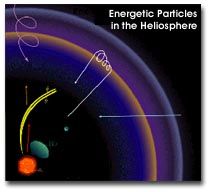
Cosmic Rays in the Heliosphere - Particles are accelerated in the solar system at shocks where co-rotating high-speed solar wind streams interact with slower solar winds, at shocks driven by CMEs, and at the solar wind termination shock. In addition to the study of acceleration processes, cosmic ray transport in the heliosphere is investigated as a necessary component to understand other cosmic ray observations. Cosmic ray intensity can also provide a diagnostic of solar wind conditions complementary to conventional plasma and magnetic field measurements.
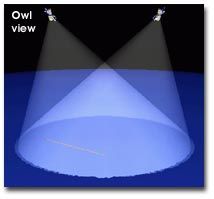
High Energy Cosmic Rays - Acceleration of galactic cosmic rays by supernova remnants should be limited to about 1015 eV, because particles of higher energy cannot be contained, and therefore cannot be accelerated, within the remnants. This idea is supported by a change in the spectral shape of the light output at about this energy, which may indicate the presence of an additional source of cosmic rays, perhaps extragalactic in origin. The limits of supernova shock acceleration and the signature of any new sources are being actively studied.
Ultra High Energy Cosmic Rays - Cosmic rays have been measured with energies as high as 3 x 1020 eV. How subatomic particles obtain these enormous energies is one of the biggest questions in Astrophysics. Energy loss due to interactions with the microwave background should restrict the origin of these particles to within 50 Mpc. Yet no sources are seen within this volume. Because these particles are extremely rare, determining what these particles are and where they come from will push current technological limits, and is one of the major goals for the future.
